
1.22.25 – SSI – Shane Clary
The 2025 edition of the National Fire Alarm and Signaling Code (NFPA 72) is now available for purchase and review through the NFPA.
After three years of work by the various technical committees, the correlating committee and the staff of the National Fire Protection Association (NFPA), the 2025 edition of NFPA 72, National Fire Alarm and Signaling Code, has been published.
This edition is now available for purchase and review through the NFPA. In a series of articles, I will cover the changes that have been made from the 2022 edition to the 2025 edition.
Depending on the area in which you perform your fire alarm work, the 2025 edition may become effective this year; meanwhile, in other areas, it may a few years from now. The first adoption will most likely be with the United States federal government, which uses the most recent published standards.
As the 2025 edition is adopted, you should remember to check for any state or local amendments that may have been made.
A Number of New Definitions in NFPA 72
In this article, I will cover a number of new definitions that have been added, plus some changes that have been made to a few of the existing definitions. They are found in Chapter 3, Definitions.
3.3.31 Auxiliary Service Provider (ASP)
An entity or service that receives signals from a protected premises fire alarm system, modifies or manipulates the signals, and directs the signals to the supervising station and is positioned in the network topology such that signals cannot reach the supervising station without the entity or service. (SIG-SSS)
This definition was added to describe a means by which a third party is used to transmit the signals from a protected premises to the supervising station. This typically would be a cloud-based service in which there are now several providers of this service.
3.3.39 Carbon Monoxide Source
Equipment or a permanently installed appliance, fireplace or process used inside a building that produces or emits carbon monoxide gas. (SIG-IDS)
Although carbon monoxide alarms and detectors have been in the standard for several editions, there was not a definition as to the source of CO. This expands the assumed source to beyond fuel-burning appliances.
3.3.79 Detector
A device suitable for connection to a circuit that has a sensor that responds to a physical stimulus, such as gas, heat, light, sound or smoke. (SIG-IDS)
The definition for detector was changed to add the words “light” and “sound.” This was done so as to incorporate new methods of detection that have come into the market and that were not part of NFPA 72. These include the following:
3.3.79.1 Acoustic Leak Detector
A device that detects the presence of a gas leak through detection of the sound produced by a pressurized gas release. (SIG-IDS)
3.3.79.26 Thermal Image Fire Detector
An initiating device that senses overheated combustible material by imaging in the long-wave infrared wavelengths (i.e., far infrared) using a focal plane array. (SIG-IDS)
Definitions Were Added
With the publication of NFPA 715, Standard for the Installation of Fuel Gases Detection and Warning Equipment, the following definitions were added:
3.3.79.11 Fuel Gas Detector
A device having a sensor that responds to fuel gas that is connected to an alarm control unit. [715, 2023] (SIG-IDS)
3.3.132 Fuel Gas Warning Equipment
Any detector, alarm, device or material related to single- and multiple-station alarms or household fuel gas detection systems. [715, 2023] (SIG-IDS)
In addition, the technical committee on Household Systems added a new definition for Fuel-Burning Equipment to clarify that the fuel could be something other than a gas.
3.3.131 Fuel-Burning Equipment
Any device that burns solid, liquid or gaseous fuel or a combination thereof. (SIG-HOU)
A significate change was made to the definition for Managed Facilities-Based Voice Network.
3.3.172 Managed Facilities-Based Voice Network (MFVN)
A physical facilities-based network capable of transmitting real-time signals with formats unchanged that is managed, operated and maintained by the regulated communications carrier to ensure service quality and reliability from the subscriber location to the supervising station via the public-switched telephone network (PSTN) or interconnection points with other MFVN peer networks. (SIG-SSS)
In the past, the definition had only referenced the “service provider.” This change makes it clear that a MFVN must be maintained by a regulated communications carrier, and that the signal must be reliable from the protected premises to the supervising station.
3.3.190 Network Connectable Equipment
System components that connect to the internet or external systems through wired or wireless pathways using various protocols.
As the use of networks increase as a part of a fire alarm system, this definition was added to acknowledge that these can be hardwired or wireless.
‘Personnel’ Descriptions
Two new definitions were added to the “personnel” descriptions:
3.3.213.1 Authorized Personnel
The property owner, or designated representative appointed or selected by the property owner, who performs certain duties. (SIG-FUN)
3.3.213.2 Emergency Personnel
Person(s) who have been trained in emergency response. (SIG-FUN)
Finally, as cybersecurity gains a stronger foothold within NFPA 72, a definition for Cybersecurity Software was added.
3.3.293.3 Cybersecurity Software
Software that is included in a system element and arranged such that its inclusion or exclusion in no way affects the executive or site-specific software execution and whose purpose is to reduce the vulnerability of the system and/or equipment to cybersecurity attacks. (SIG-FUN)
About the Author

Shane Clary, SSI Contributor
Shane Clary, Ph.D., is Security Sales & Integration’s “Fire Side Chat” columnist. He has more than 37 years of security and fire alarm industry experience. He serves on a number of NFPA technical committees, and is vice president of Codes and Standards Compliance for Pancheco, Calif.-based Bay Alarm Co.
